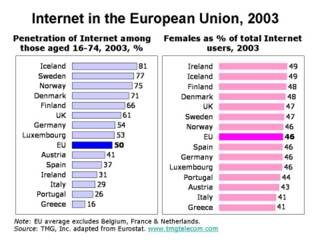
European countries have bound together as the European Union and established a common currency, the Euro. This collaboration has also extended to measuring Internet users. The Statistical Office of the European Communities (EUROSTAT) has been coordinating standard household surveys so that inter-country comparisons of Internet use are more accurate. Just as all countries have not embraced the Euro, not all have adopted the standard methodology for measuring Internet use. However a majority has and in 2003, 12 western European Union statistical offices (along with Iceland and Norway) carried out surveys measuring Internet use among those between the ages of 16 and 75. The Nordic nations lead the pack while Greece finishes last. Half of the European Union population was online in 2003 but there is a massive digital divide even among such a fairly homogenous group. Iceland leads the pack with some 4 out of 5 people using in the Internet; at the other extreme, less than one in five Greeks are online. The data are also disaggregated by sex, age and other characteristics. So while the Irish may not be tops in Internet use, they rank high in gender equality with women using the Internet in almost the same proportion as men. The standard questionnaire is a major breakthrough in measuring Internet penetration and hopefully more regions will follow suit. The Asia-Pacific Internet Research Alliance (APIRA) is trying to do the same thing for Asia; one issue is that the sample population for the Asian nations includes those from six years old, distorting comparisons with European countries.
The EUROSTAT survey is available here.
A summary of the results is available here.

No comments:
Post a Comment